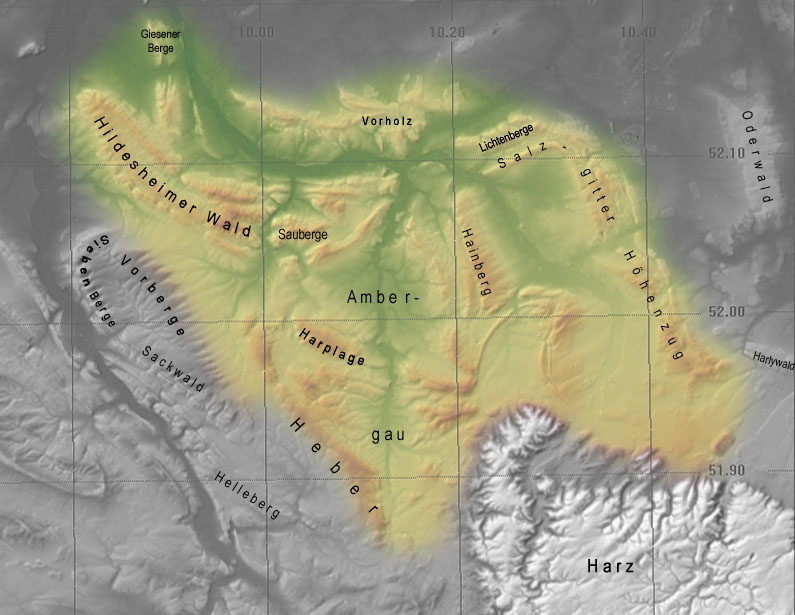Ambergau on:
[Wikipedia]
[Google]
[Amazon]
The Ambergau is a historic landscape and natural region unit in the 

Innerste Uplands
The Innerste Uplands (german: Innerstebergland) is a landscape region up to 359 m high and covering an area of over 900 km² in the northern part of the German Central Uplands. It lies within the eastern part of the Weser-Leine Uplands ...
in southern Lower Saxony, Germany. It is a basin, about 10 x 10 kilometres across, with 18 settlements (there were 31 in the Middle Ages), the centre and capital of which since the 13th century is the town of Bockenem
Bockenem (; Eastphalian: ''Bokeln'') is a town in the district of Hildesheim, Lower Saxony, Germany that was founded in 1154. It is located on the German Timber-Frame Road.
Surrounding villages
*Jerze
*Königsdahlum
*Bornum
*Mahlum
*Schlewecke ...
. The basin, with its fertile agricultural fields, is surrounded by the wooded ridges of Heber, the Harplage
The Harplage is a hill range, up to 290 metres high, located west-northwest of the Harz in the southeast of the German state of Lower Saxony.
Geography
The forested Harplage is located in the district of Hildesheim in the southwestern part ...
, the Weinberg and the Hainberg. The '' Gau'' is a cultural landscape
Cultural landscape is a term used in the fields of geography, ecology, and heritage studies, to describe a symbiosis of human activity and environment. As defined by the World Heritage Committee, it is the "cultural properties hatrepresent the co ...
that was formed as early as the 8th century.

Name
The name Ambergau is a combination of the German words ''Amber'' and ''Gau''. ''Amber'' has its origin in the Proto-Indo-European language and has the word stem ''mb(h)'', was means something like dampness. That is probably related to the wet areas that existed at that time, like those of the RiverNette
Nette can refer to: Rivers
* Nette (Innerste), a river in Lower Saxony, Germany, tributary to the Innerste
* Nette (Hase), a river in Lower Saxony, Germany, tributary to the Hase
* Nette (Middle Rhine), a river in Rhineland-Palatinate, Germany, tr ...
. Gau is a word for the enclosed settlement area of Germanic peoples. The term ''Ambergo'' was also used.

Location and land use
The Ambergau lies between the northwestern edge of the Harz Mountains and theHildesheim Börde The Hildesheim Börde (german: Hildesheimer Börde or ''Braunschweig-Hildesheimer Lössbörde'') is a natural region, 272 km2 in area, in the northern part of Hildesheim district, which is known for its especially rich black earth loess soil.
L ...
. The hill ridges surrounding it are predominantly covered by beech
Beech (''Fagus'') is a genus of deciduous trees in the family Fagaceae, native to temperate Europe, Asia, and North America. Recent classifications recognize 10 to 13 species in two distinct subgenera, ''Engleriana'' and ''Fagus''. The ''Engle ...
woods. The basin-shaped valley is today a largely treeless arable farming region that has probably always been used by man for that purpose. Agriculture was the dominant industry until the 20th century. A moderate degree of industrialization began in 1727 in Bornum with a blast furnace
A blast furnace is a type of metallurgical furnace used for smelting to produce industrial metals, generally pig iron, but also others such as lead or copper. ''Blast'' refers to the combustion air being "forced" or supplied above atmospheric ...
firm. Duke Augustus William of Brunswick-Wolfenbüttel
Caesar Augustus (born Gaius Octavius; 23 September 63 BC – 19 August AD 14), also known as Octavian, was the first Roman emperor; he reigned from 27 BC until his death in AD 14. He is known for being the founder of the Roman Pri ...
had iron produced in the Wilhelmshütte smeltery.
The Ambergau is bisected from south to north by the River Nette. The bigger lines of communication also run in a north–south direction through the region. These are the goods line from Derneburg to Bornum, the B 243 federal highway and the A 7 motorway.
Settlement
Today
The 18 present-day settlements in the Ambergau, all within the borough ofBockenem
Bockenem (; Eastphalian: ''Bokeln'') is a town in the district of Hildesheim, Lower Saxony, Germany that was founded in 1154. It is located on the German Timber-Frame Road.
Surrounding villages
*Jerze
*Königsdahlum
*Bornum
*Mahlum
*Schlewecke ...
, are:
Middle Ages
In addition, during the Middle Ages, there were 13 other settlements in the Ambergau, that were given up during the periods of abandonment (''Wüstungsperiode'') in the 14th and 15th centuries. These were:Literature
* Friedrich Günther: ''Der Ambergau.'' Meyer, Hannover 1887 (Unveränderter Neudruck. Sändig, Walluf bei Wiesbaden 1974, . * Manfred Klaube: ''Der Ambergau. Wirtschafts-, Sozial- und Politikgeschichte.'' Papierflieger, Clausthal-Zellerfeld 2001, . * Manfred Klaube: ''Kriegs- und Nachkriegsjahre in der Provinz. Bockenem und der Ambergau 1939 bis 1949.'' Eigenverlag, Bockenem, 2008. {{Coord, 51, 58, , N, 10, 08, , E, region:DE-NI_dim:20000, display=title Regions of Lower Saxony Natural regions of the Weser-Leine Uplands